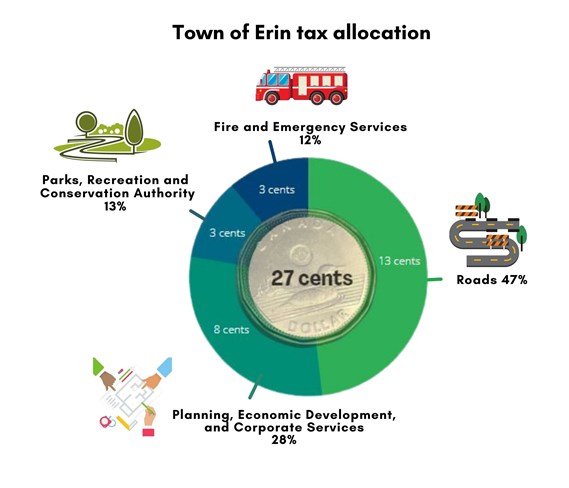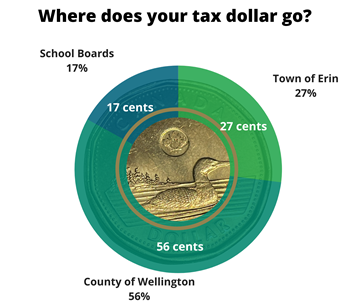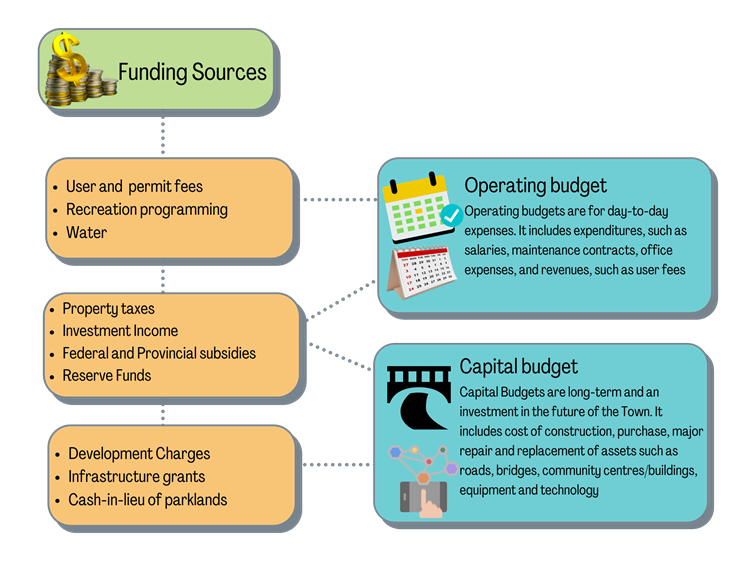
Where does your tax dollar go? How is the Town of Erin's portion of the tax dollar distributed? Budget Guide pdf

 Every tax dollar collected as part of the property tax is divided as follows:
Every tax dollar collected as part of the property tax is divided as follows:
- 17 cents to the School Board;
- 56 cents to the County of Wellington
- 27 cents to the Town of Erin
From the 27 cents of every dollar of the property tax that the Town receives, the top four areas of expenditure are as follows:
- Roads - 13 cents
- Planning, Economic Development and Corporate Services - 8 cents
- Parks Recreation, Conservation Authorities - 3 cents
- Fire and Emergency - 3 cents
What are the Town's long term goals?
- To maintain assets and keep the Town's assets such as roads, bridges, buildings in a state of good repair.
- Invest in the community and improve and increase services to keep up with growth.
- Invest for the town's future and put aside funds to pay for future needs and improvement.
The annual budget is divided into two parts - Operating Budget and Capital Budget
![]()
Operating Budgets are for day-to-day expenses to keep the Town's operations running. They include expenditures such as salaries, maintenance contracts, office expenses, and revenues from user fees. The operating budget includes project revenues and expenditures for the year.

![]()
Capital Budgets are long-term and reflect an investment in the future of the town. They include costs of purchase, construction, major repair, replacement and renewal of assets such as roads, bridges, buildings, equipment and technology.
Impact of Capital Budgets on Operating Budgets
Assets have a useful life beyond one year.
After the initial purchase of an asset, which comes out of the Capital Budget, it is put into use. The asset then incurs operating costs, examples include:
- Recreation centres require staff (facility operators)
- Buildings require utilities such as lights, heat and electricity
- Equipment requires staff to run it and often needs electricity or fuel
- The assets need to be maintained in a state of good repair
- And, as they are used, assets eventually wear down or become obsolete
As these assets wear down, money must be allocated from the Operating Budget each year to pay for regular maintenance, and some money is also set aside into the Capital Budget for repairs and replacement.
Ongoing vs One-time Costs
ONGOING costs are continual and extend beyond the current year, examples include:
- Staff salaries, fuel, maintenance contracts
- Funding for ongoing costs must be sustainable and from ongoing revenue streams (e.g. property taxes)
- Cannot be sustained by funding from one-time surpluses
- Included in the base budget
ONE-TIME costs occur once and do not continue beyond the current year, examples include:
- A one-time purchase would be hiring a third party expert for a specific service or relocation of offices
- It may be funded from a reserve or an annual operating surplus
- Not part of the base budget
What are the funding sources for municipal services and what are restrictions on the various funding sources?

 Skip to main content
Skip to main content